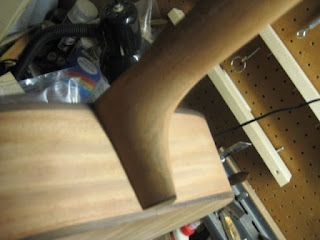Here's the body before I started work on the neck fit.


And here's what the fingerboard extension was looking like as the neck was getting lower.

...and lower...

Until finally, the neck was just about flush with the body.




After I got the neck fit good, I trimmed the end of the heel and installed a heel cap. Did John Hall include a little piece of Brazilian Rosewood for this? I think it is. Looks like it. Had a real sweet smell as I was cutting it. (I'd never cut Brazilian before).

First I trimmed it down with a chisel.

Then I worked on it with sandpaper.




Before I put finish on the body, I thought it would be a good idea to sand the underside of the bridge so that it will fit the top.


Getting closer...






































